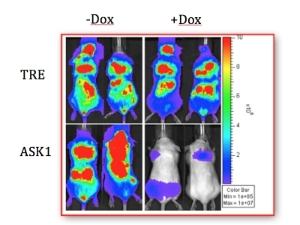 Members: Hsia-Yuan Ying, Kou-I Lin, Fan-Ru Lin (from left to right)Dr. Kuo-I Lin has been studying the mode of action of Blimp-1, which is a master regulator of cellular differentiation in the immune system, for more than a decade. Lately, she has published several papers and pushed the study to a higher level of clarity regarding the mystery of B cells, Blimp-1 and plasma cells.
Members: Hsia-Yuan Ying, Kou-I Lin, Fan-Ru Lin (from left to right)Dr. Kuo-I Lin has been studying the mode of action of Blimp-1, which is a master regulator of cellular differentiation in the immune system, for more than a decade. Lately, she has published several papers and pushed the study to a higher level of clarity regarding the mystery of B cells, Blimp-1 and plasma cells.
There are millions variations of B cells, and when a certain type of B cells are called on duty, their mission is to make specific plasma cells, which act as sole purpose factories focusing on making a specific type of antibodies.
Prior work done by Lin has proved that Blimp-1 is a crucial protein existing within the plasma cell for such duty, however, how exactly its role is was not fully understood.
In the studies published lately, Lin’s group has clearly exhibited how Blimp-1 coordinates other molecules within the cell in the course of actions in regulating gene expressions and finally come up with plasma cells. Furthermore, how Blimp-1 later inhibits ASK1 to maintain the survival of plasma cells residing inside bone marrow.
Lin approached the tasks by first using a simulation program to identify all possible residues that could be post-translationally modified on Blimp-1. Through a series of validation including Mass Spectrometry technology, they have identified a tiny protein called SUMO as a key player.
In fact, the group has proposed a Standard Operation Procedure (SOP)-like series of actions. The final story is, upon intrusion by an antigen, within the B cell, Blimp-1 will be induced and interact with a PIAS1 molecule, then, SUMO comes into the picture to bind to Blimp-1 covalently through a site at K816; and only then Blimp-1 will further interact with HDAC2, and completes the journey of plasma cell differentiation. Throughout this chain of actions, it is proved that SUMO is a must have ingredient for Blimp-1’s action.
On the other hand, Lin also pursued the follow up monitoring of the plasma cells, she wants to know why some plasma cells seem to have a longer life span.
 This diagram shows how induction of ASK1 inhibits tumor cells proliferation. All tested mice were injected with multiple myeloma cells, while the TRE set is considered control set, the ASK1 set is for observing the relationship in between ASK1 and tumor cells. Test result shows at day 20, the ones in ASK1set that have been treated with Dox to induce ASK1amount have no more tumor cells(right bottome), while the ones without the Dox induction have more tumors(bottom left).When the plasma cells are done with their duty in producing antibodies, they will be stored inside bone marrow quietly. Regular plasma cells won’t proliferate, they just perform the duty of secreting antibodies, until it reaches its natural life expectancy.
This diagram shows how induction of ASK1 inhibits tumor cells proliferation. All tested mice were injected with multiple myeloma cells, while the TRE set is considered control set, the ASK1 set is for observing the relationship in between ASK1 and tumor cells. Test result shows at day 20, the ones in ASK1set that have been treated with Dox to induce ASK1amount have no more tumor cells(right bottome), while the ones without the Dox induction have more tumors(bottom left).When the plasma cells are done with their duty in producing antibodies, they will be stored inside bone marrow quietly. Regular plasma cells won’t proliferate, they just perform the duty of secreting antibodies, until it reaches its natural life expectancy.
What Dr. Lin has found was, within the plasma cell, there is a hidden danger called ASK1 that was expressed in a trace level. ASK1 and Blimp-1 somehow work in a tug-of-war fashion within the plasma cell because Blimp-1 turns down the expression of ASK1. When Blimp-1 level is inhibited, ASK1 level will be increased, leading to the death of the plasma cell. By observing mouse normal plasma cells and human bone marrow plasma cells from patients with multiple myeloma (MM), the malignant plasma cells, their result showed that suppression of ASK1 is crucial for cell survival because its enforced expression in plasma cells caused apoptosis in vitro and lowered MM load in an animal model with human MM cells transplanted.
Furthermore, alteration of ASK1 activity affected MM cell survival. The findings indicate a novel mechanism underlying the regulation of survival in normal and malignant plasma cells by ASK1.
Lin and her group shows excitement and confidence in drilling down further in their study of Immunology, hoping that better understanding will eventually bring better therapeutics.
The study of SUMO and Blimp-1 has been published by the journal “EMBO reports” in the July 2012 print edition with a cover diagram clearly depicts the course of actions of Blimp-1 on its way to help push B cells into plasma cells. An A-IMBN Research highlight of this research was followed on August 8. See http://www.natureasia.com/A-IMBN/article.php?id=635
The study “ASK1 promotes apoptosis of normal and malignant plasma cells” has been published on the August 2nd edition under of the journal “Blood”. See http://bloodjournal.hematologylibrary.org/content/120/5/1039.abstract

